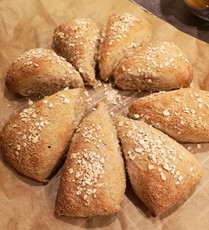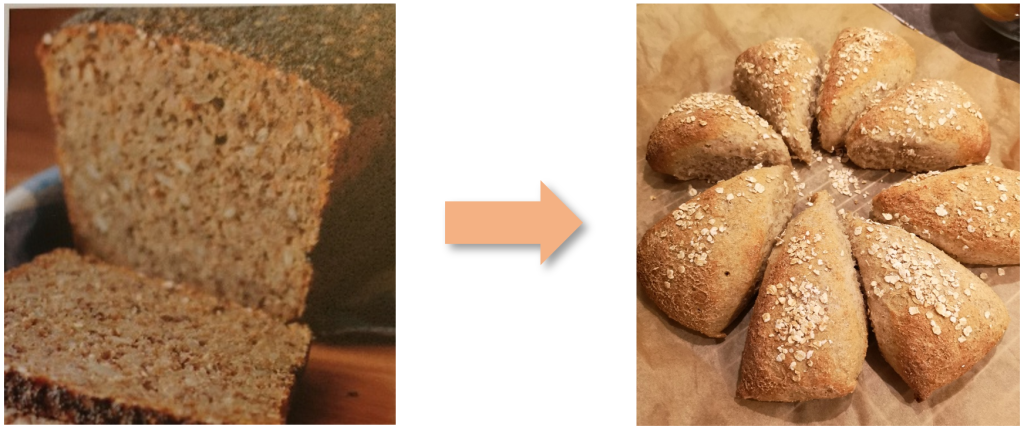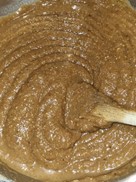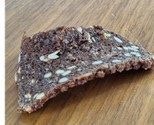
Upcycling bread
Resurrect your Bread – again and again…

Reusing old bread in new bread recipes is a common way to use leftovers from a previous bread production.
According to various experiments (in house), it is possible to add up to 20% old bread in a bread recipe – of the same type of bread. There is a few conditions, which must be met in the process.
The bread should not be moulded in any way it is easy to smell if the bread has started to mould – it smells like an “old wet basement” or if the mould is visible on the bread. Discharge the whole bread if it is mouldy.
The bread can either be cut in smaller pieces and soaked in liquid (water/milk) or dried and granulated before adding it to the recipe. Some prefer to remove the crust as it could leave dark impurities in the finished bread.
The crust can be fed to the ducks in the park.
Bread with without kernels or seeds is to be preferred as these can add a shorter shelf/storage life to the fresh bread.
Overbaked bread, dark and burned cannot be reused, as this is first, unhealthy and secondly, gives the new bread unwanted bitterness and an unpleasant flavour.
Under baked bread, compact and hard is not recommendable to use – as this can be difficult to dry and blend into
smaller pieces.
Use white bread to white bread recipes – and rye bread to rye bread recipes – all though it could be subject to making experiments in the kitchen – as you can always reuse the mistakes again.. 😊
From lunch to breakfast and dessert
Rye bread is a common type of bread, we (the Danes) eat it in our open sandwiches and to many of our meals
it is main a part of our food culture. Taking this in to account – we often reuse the rye bread in many different ways.
Breakfast:
We reuse the dried and granulated rye bread on our yoghurt as rye bread granola, mixed with sugar, honey, dried fruits and oat flakes – the luxurious variant of the granola is roasted in salted butter and added hazelnuts
– a piece of heaven on your yoghurt.
Øllebrød/bread Porridge

Sometimes we make “Øllebrød” for breakfast – it is a kind of porridge made by rye bread and beer – what is not to like.
We soak the rye bread in ½ water and ½ dark beer in a pot – and heats it slowly.
Adding a little bit of sugar/honey to the porridge, not too much, just enough to taste some sweetness. The porridge should boil for 10 minutes and blended and sifted, to remove kernels or unwanted pieces of crust from the rye bread.
The ”Øllebrød” can be served Luke or chilled with whipped cream or vanilla cream (in the summertime) as breakfast and a solid start of the day.
Rye bread as a crisp accessory in the menu

Chips made of fine sliced rye bread, roasted in the oven with a pinch of sea salt added, and is a perfect “crunchy” companion to fish, tapas, shellfish and soups.
Without the salt, the chips can be served to desserts as “bread tuilles” giving the dessert a crispy texture.
Reuse rye bread in a cake – bread pie
One of our famous cake recipes is called “Brødtærte” (bread pie) and its history dates back to the 1920’s when the southern part of Denmark, became Danish again by voting – after German occupation from 1864.
In short, it is a cake based on rye bread, which gives it a rich flavour, and a good texture, mixed with whipped cream, hazelnuts and blackcurrant marmalade.
Rye bread layer cake – originally called bread pie or bread cake – is known from Southern Jutland. It is one of the coffee table’s most famous cakes.
Recipe
6 pcs. eggs
100 gr fine grated rye bread (without kernels/seeds)
1 tsp baking powder
250 gr sugar
100 gr chopped hazelnutsFilling
0,5 liter whipping cream (38% fat)
50 gr roasted and fine chopped hazelnuts
150 – 200 gr blackcurrant marmalade/jamWorkflow
Use fresh but dry rye bread that is finely grated. Nowadays, this is most easily done on a food processor. This allows you to grate the crusts and they give a good taste.
The nuts should not be chopped to a too small size.
Divide the eggs into whites and yolks in separate bowls. The 6 egg whites are whipped stiff. The sugar is gently stirred into the egg whites little by little. The egg yolks are added one at a time to the dough keeping it fluffy.
The finely grated rye bread and the not too finely chopped nuts are mixed together and added carefully.
1 teaspoon baking powder is mixed in the dough.The dough is poured into either 3 cake tins of the same size – approx 2 cm high in each tin – or one single cake tin 8 – 10 cm high with greased baking paper as they tend to stick to the bottom. Bake immediately at 180 C degrees for about 6- 8 minutes for the layers or 40 minutes at 160 C – until testing that there is no dough sticking to a knife, placed in the middle of the cake…
Let the cake cool of – about an hour on the kitchen table.
If the cake has been baked in one tin – then carefully slice the cake into 3 sliced layers (horizontal).
When serving, add the layer cake bases together with a layer of blackcurrant marmalade and on top a layer of whipped cream.
Finish with a layer of whipped cream on top and sprinkle with some roasted and fine chopped hazelnuts and/or grated dark chocolate.
It is my favorite party pie, which is easy to make and should preferably be eaten immediately. There are several recipes for bread pie, and it was one of those cakes that the housewife used to take pride in baking as well as possible.
Bread pie can be varied in several ways, e.g. by adding fine chopped dark chocolate or a little cocoa powder to the dough before baking it. The cake can be added some seasonal berries – strawberries, raspberries or cooked rhubarbs, etc. between the layers.
Good luck reusing your bread.
Article by:

Dan Feld-Jacobsen
Chef teacher at EUC Syd




